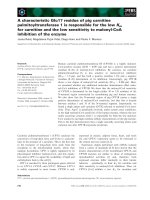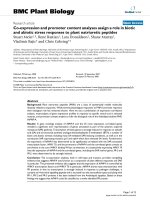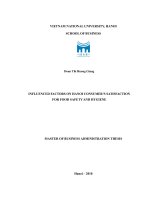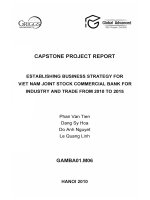Macroeconomics for professionals a guide for analysts and those who need to understand them
Bạn đang xem bản rút gọn của tài liệu. Xem và tải ngay bản đầy đủ của tài liệu tại đây (4.38 MB, 312 trang )
MACROECONOMICS FOR PROFESSIONALS
Understanding macroeconomic developments and policies in the
twenty-first century is daunting: policymakers face the combined challenges of supporting economic activity and employment, keeping
inflation low and risks of financial crises at bay, and navigating the
ever-tighter linkages of globalization. Many professionals face demands
to evaluate the implications of developments and policies for their
business, financial, or public policy decisions. Macroeconomics for
Professionals provides a concise, rigorous, yet intuitive framework for
assessing a country’s macroeconomic outlook and policies. Drawing on
years of experience at the International Monetary Fund, Leslie
Lipschitz and Susan Schadler have created an operating manual for
professional applied economists and all those required to evaluate
economic analysis.
Leslie Lipschitz was an economist at the International Monetary Fund
for more than thirty-five years. He served as Director of the IMF
Institute, taught at the School of Advanced International Studies at
Johns Hopkins University and at Bowdoin College, was a guest scholar
at the Brookings Institution, worked and consulted with private financial institutions, and has written, spoken, and published widely on
open-economy macroeconomics.
Susan Schadler was an economist at the International Monetary Fund
for over thirty years. Her published articles and books cover exchange
rate policies, economic growth and crises, how countries adjust in
crises, and the integration of Eastern and Western Europe. Since
leaving the IMF, she has been a senior member of St Antony’s
College, Oxford University, senior fellow at the Atlantic Council and
the Centre for International Governance Innovation, and consultant
for the IMF’s Independent Evaluation Office.
Macroeconomics for Professionals
A Guide for Analysts and Those Who Need to
Understand Them
leslie lipschitz
Bowdoin College
susan schadler
Center for International Governance Innovation
University Printing House, Cambridge cb2 8bs, United Kingdom
One Liberty Plaza, 20th Floor, New York, ny 10006, USA
477 Williamstown Road, Port Melbourne, vic 3207, Australia
314–321, 3rd Floor, Plot 3, Splendor Forum, Jasola District Centre,
New Delhi – 110025, India
79 Anson Road, #06–04/06, Singapore 079906
Cambridge University Press is part of the University of Cambridge.
It furthers the University’s mission by disseminating knowledge in the pursuit of
education, learning, and research at the highest international levels of excellence.
www.cambridge.org
Information on this title: www.cambridge.org/9781316515891
doi: 10.1017/9781108598293
© Leslie Lipschitz and Susan Schadler 2019
This publication is in copyright. Subject to statutory exception
and to the provisions of relevant collective licensing agreements,
no reproduction of any part may take place without the written
permission of Cambridge University Press.
First published 2019
Printed in the United Kingdom by TJ International Ltd. Padstow Cornwall
A catalogue record for this publication is available from the British Library.
Library of Congress Cataloging-in-Publication Data
names: Lipschitz, Leslie, author. | Schadler, Susan, author.
title: Macroeconomics for professionals : a guide for analysts and those who need to
understand them / Leslie Lipschitz, Bowdoin College, Maine, Susan Schadler, Center
for International Governance Innovation.
description: New York : Cambridge University Press, [2018] | Includes bibliographical
references and index.
identifiers: lccn 2018025214| ISBN 9781316515891 (hbk. : alk. paper) | isbn
9781108449830 (pbk. : alk. paper)
subjects: lcsh: Macroeconomics.
classification: lcc hb172.5 .l57 2018 | ddc 339–dc23
LC record available at />isbn 978-1-316-51589-1 Hardback
isbn 978-1-108-44983-0 Paperback
Cambridge University Press has no responsibility for the persistence or accuracy of
URLs for external or third-party internet websites referred to in this publication
and does not guarantee that any content on such websites is, or will remain,
accurate or appropriate.
For Charlotte, Jessica, and Vanessa. After the years of enduring
(and sometimes being moved to engage in) ferocious dinner-table
debate on issues of political economy, much of what's in this book
may seem like old hat.
And for our former colleagues at the IMF who honed our
commitment to getting the macroeconomic diagnosis and
policy prescription right.
Contents
Acknowledgments . . . . . . . . . . . . . . . . . . . . . . . . . . page ix
Glossary of Symbols and Acronyms . . . . . . . . . . . . . . . . . . . . x
Preface . . . . . . . . . . . . . . . . . . . . . . . . . . . . . . . . . xvii
1
Introduction, Motivation, and Overview . . . . . . . . . . . . . . . 1
2
Real Economic Activity . . . . . . . . . . . . . . . . . . . . . . . . 7
1 The Supply Side . . . . . . . . . . . . . . . . . . . . . . . . . .
2 The Demand Side . . . . . . . . . . . . . . . . . . . . . . . . .
3 Playing with the Concepts: Macroeconomic Shocks and
Policy Responses . . . . . . . . . . . . . . . . . . . . . . . . . .
4 Exercises . . . . . . . . . . . . . . . . . . . . . . . . . . . . . .
3 Inflation, Relative Prices, and Expectations . . . . . . . . . . . . .
1 The Price Level, Inflation, and Deflation . . . . . . . . . . . . .
2 Macroeconomic Aspects of Relative Prices . . . . . . . . . . . .
3 Intertemporal and International Linkages: Interest Rates
and Expectations . . . . . . . . . . . . . . . . . . . . . . . . . .
4 Exercises . . . . . . . . . . . . . . . . . . . . . . . . . . . . . .
4 Monetary Policy and Accounts . . . . . . . . . . . . . . . . . . .
1
2
3
4
Monetary Policy Frameworks . . . . . . . . . . . . . . . . . . .
Policymaking under IT . . . . . . . . . . . . . . . . . . . . . .
Reading the Monetary Accounts . . . . . . . . . . . . . . . . .
Countercyclical Policy and the Central Bank Balance
Sheet in Practice . . . . . . . . . . . . . . . . . . . . . . . . .
10
28
45
51
53
55
61
82
92
95
96
108
114
120
vii
viii
Contents
5 Monetary Policy and Vulnerabilities . . . . . . . . . . . . . . . 128
6 Exercises . . . . . . . . . . . . . . . . . . . . . . . . . . . . . . 141
5 The Fiscal System . . . . . . . . . . . . . . . . . . . . . . . . . 147
1 The Government Accounts . . . . . . . . . . . . . . . . . . . . 149
2 Assessing the Macroeconomic Effects of Fiscal Policy . . . . . 159
3 Fiscal Rules: A Bulwark against Short-Term Political Pressures . 183
4 Thought Experiments . . . . . . . . . . . . . . . . . . . . . . 186
5 Exercises . . . . . . . . . . . . . . . . . . . . . . . . . . . . . 188
6 Financial Stability . . . . . . . . . . . . . . . . . . . . . . . . . . 191
1 Bank Regulation: An Intuitive Sketch of
Prudential Considerations . . . . . . . . . . . . . . . . . . . .
2 Bank Regulation: Terms, Definitions, and Difficulties . . . . .
3 The Anatomy of an EM Balance Sheet Crisis . . . . . . . . . .
4 Balance Sheet Crises and Financial Assessment in
Advanced Countries . . . . . . . . . . . . . . . . . . . . . . .
5 Exercises . . . . . . . . . . . . . . . . . . . . . . . . . . . . .
7 The External Accounts . . . . . . . . . . . . . . . . . . . . . . .
1
2
3
4
Understanding the External Accounts . . . . . . . . . . . . . .
The Main Objectives of External Account Analysis . . . . . . .
External Vulnerability and Risk Assessment . . . . . . . . . . .
Exercises . . . . . . . . . . . . . . . . . . . . . . . . . . . . .
193
196
206
215
223
225
226
239
256
264
Index . . . . . . . . . . . . . . . . . . . . . . . . . . . . . . . . . . 268
Acknowledgments
The authors owe a debt of gratitude to too many former colleagues at the
IMF and to economists in government statistical agencies to mention
individually; some are acknowledged in the specific areas where they
provided data or input. Bas Bakker (at the International Monetary Fund)
and David Vines and Adam Bennett (at Oxford University) read an early
draft of the manuscript and provided insightful suggestions. Claudio Borio
and Ingo Fender (at the Bank for International Settlements) helped
improve Chapter 6. Anonymous reviewers, students at Bowdoin College
and in an MBA class taught by one of the reviewers, and (perhaps unwittingly) colleagues at Investec Asset Management also helped shape the
book. Elizabeth Weston of the Bowdoin College Economics department
provided excellent technical and editorial assistance. The authors alone are
responsible for any remaining errors.
ix
Glossary of symbols and acronyms
Upper and lower-case letters
Except for interest rates (which are always in small-case letters), most
variables are written in capital letters for levels of the variable and small
letters for growth rates (or percentage changes) or for ratios of variables to
GDP. Which of the two is in use for any specific small letter symbol should
explicit in the text or clear from the context.
Subscripts
g
i
n
p
r
t, t + 1
designates government (as opposed to private)
designates one component of an aggregate measure
designates a nominal or current price (as opposed to a real or
constant price) measure, except when it is used on “P” when it
designates the price of nontraded goods
designates private (as opposed to government)
designates a real or constant price (as opposed to nominal or
current price) measure
designate time periods
Superscripts
*
$
x
designates a target value (e.g., for the inflation rate), a potential
value (e.g., for potential output or growth), or a cyclically neutral
value (e.g., for the cyclically neutral interest rate, structural, or
cyclically-adjusted, fiscal aggregates)
designates that the variable is measured in US dollars
Glossary of symbols and acronyms
e
d
f
w
e
designates an expected value. Thus Etþ1
is the value of the exchange
rate expected one period in the future
designates domestic variables, such that id is the domestic interest
rate and Dd the stock of government debt in domestic currency
designates foreign, such that if is the foreign interest rate and Df the
stock of government debt in foreign currency
designates that a variable is measured in US dollars
Greek symbols
α
1-α
β
1-β
ε
γr
γe
π
= share of capital in production and income
= share of labor in production and income
= share of traded goods in the CPI
= share of nontraded goods in CPI
= percentage change in the exchange rate, such that a positive
number is a depreciation of the home currency
= the elasticity of revenue to nominal income
= the elasticity of expenditure to nominal income
= the aggregate inflation rate (abstracting from the particular price
index)
Symbols and acronyms
A = TFP
ABS
ARA
AT1
BCBS
BIS
BOP
C
CAB
CAD
CB
CET1
CiB
CiC
CFM
CO
= total factor productivity
= absorption
= IMF’s analysis of reserve adequacy metric
= additional tier 1 capital
= Basel Committee on Banking Supervision
= Bank for International Settlements
= balance of payments
= consumption
= current account balance = X – M + NFI + TR
= -CAB = current account deficit of the balance of payments
= central bank loans to the banking system
= common equity tier 1 capital
= currency in banks
= currency in circulation
= capital flow management (policies)
= other claims of the banking system (i.e., those on the private
nonbank sector). A suffix “1” refers to the central bank, a suffix
xi
xii
Glossary of symbols and acronyms
CoB
CPI
D
DD
Def
DEP
DIs
DSA
DSGE
E
E&O
EBA
EFA
EM
ER
Exp
F
FA
FB
FCL
FDI
FL
FDD
FSAP
FX
FXD
FXH
GDA
1
“2” refers to the commercial banks, and no suffix is used for
the consolidated banking system (or where the context is
unambiguous)
= currency outside banks
= consumer price index
= the stock of government debt or of debt to non-residents
(external debt)1
= demand deposits
= the overall government deficit (equal to -OB)
= bank deposits
= depository institutions (chiefly banks) in the accounts of the
US Federal Reserve System
= debt sustainability analysis (whether of public sector debt in
Chapter 5 or external debt in Chapter 7
= dynamic stochastic general equilibrium model
= exchange rate (domestic currency units per US dollar)
= errors and omissions (in the balance of payments)
= external balance assessment
= the external financial account of the balance of payments
= emerging market country
= excess reserves (i.e., deposits) of the banking system with
the central bank
= government expenditure
= forward exchange rate such that Fttþ1 is the forward
exchange rate for time t+1 quoted at time t
= foreign assets
= foreign balance = X – M
= Flexible Credit Line of the IMF
= foreign direct investment
= foreign liabilities
= final domestic demand = C +IF = TDD – IN
= financial sector assessment program (of the IMF and World
Bank)
= any financial aggregate denominated in foreign exchange
= deposits (of residents) in foreign currency
= foreign exchange holdings of the monetary authorities
= gross domestic absorption, identical to TDD
We use the same symbols for these two different measures of indebtedness with D referring
to public debt in Chapter 5 and to external debt in Chapter 7.
Glossary of symbols and acronyms
GDP
GFSM
GNDI
GNI
GOB
grn
grr
GS
GSIBs
i
I
IF
IMF
IN
IT
K
KAB
L
LI
LOANS
M
M1
M2
MAC
MB
MG
MPC
mpc
NAIRU
NCG
NDA
= gross domestic product
= Government Finance Statistics Manual of the IMF
= gross national disposable income
= GNP = gross national income which is sometimes called
gross national product
= gross operating balance, identical to Sg (= Rev – Cg) if Cg
excludes capital consumption (i.e., depreciation)
= the rate of growth of nominal income (that is ΔYn t/Yn t-1)
= the rate of growth of real income
= government surplus = Sg – Ig
= global systemic important banks (generally identical to
TITF)
= nominal interest rate
= total investment = IF + IN
= fixed investment
= International Monetary Fund
= inventory investment
= inflation targeting
= index of capital inputs into production
= capital account balance
= labor hours worked per period
= Laspeyres Index
= net foreign borrowing component of the net financial
balance (NFB)
= imports of goods and services
= narrow money
= broad money
= market access country (country grouping including EMs
and advanced countries)
= the monetary base (sometimes referred to as reserve
money)
= monetary gold holdings
= monetary policy committee
= marginal propensity to consume out of income
= non-accelerating inflation rate of unemployment
= net credit to government. A suffix “1” refers to the central
bank, a suffix “2” refers to the commercial banks, and no
suffix is used for the consolidated banking system (or where
the context is unambiguous)
= the net domestic assets of the central bank
xiii
xiv
Glossary of symbols and acronyms
NDCAB
NFA
NFB
NFI
NIIP
NOB
NPI
Oi
OA
OECD
OIN
OTH
P
Pi
Pn
Pw
Py
PExp
PGFR
PI
PL
PL(DC)
PL(FX)
PPF
PPP
PRIM
= non-interest current account balance plus net non-debtcreating financial inflows, all measured in dollars
= net foreign assets in the monetary balance sheet (FA – FL).
A suffix “1” refers to the central bank, a suffix “2” refers to the
commercial banks, and no suffix refers to the consolidated
banking system (or where the context is unambiguous)
= net financial balance
= net factor income from abroad
= net international investment position
= net operating balance, equal to GOB minus capital consumption; identical to Sg (= Rev – Cg) if Cg includes capital
consumption
= net primary income
= gross output of sector i
= other short-term assets in foreign currency held by the
monetary authority
= Organization for Economic Cooperation and
Development
= other items net in the balance sheet (defined as an asset). A
suffix “1” refers to the central bank, a suffix “2” refers to the
commercial banks, and no suffix is used for the consolidated
banking system (or where the context is unambiguous).
Sometimes OIN is included under a broad conception of
NDA
= other influences on the level of government debt
= the price level (when the specific index used is not
specified)
= price of value added component i of GDP
= price index of nontraded goods (and services).
= world price index (for a traded good) measured in US$
= GDP deflator
= primary expenditure
= public gross financing requirement
= Paasche Index
= private credit
= private credit in domestic currency
= private credit in foreign currency
= production possibility frontier
= purchasing power parity
= primary balance
Glossary of symbols and acronyms
prim
PROD
OB
OEB
OMC
OMOs
Qi
QE
r
R
REER
RER
Rev
rp
RPF
RT
S
SDR
SEI
TD
TDD
TFP
TITF
TOT
TR
ULC
UKC
2
= the primary balance as a ratio to nominal income (that is,
PRIM/Yn)
= productivity (output per person-hour)
= overall balance or net lending (defined as Rev – Exp)
= overall external balance
= US Federal Reserve Open Market Committee
= open market operations
= quantity of value added component i of GDP
= quantitative easing
= real interest rate
= rental cost of capital
= multilateral real effective exchange rate (a weighted index
of RERs vis-à-vis a group of countries)
= bilateral real exchange rate
= government revenue
= currency risk premium (this has the dimension of an
interest rate)2
= reserve position in the IMF (foreign currency amounts that
a member country may draw from the IMF at short notice)
= net foreign exchange reserve transactions of the central
bank = reserve loss
= gross national saving (comprising private and government
components)
= special drawing rights issued to the country by the IMF or
obtained from another country through the IMF
= seigniorage
= time deposits
= total domestic demand = C + IF + IN sometimes also
referred to as Gross Domestic Absorption (GDA)
= total factor productivity
= too important to fail (a class of large, interconnected banks)
= external terms of trade = $price of export/$price of imports
= net transfers from abroad
= unit labor cost. Lower case used to indicate a rate of
change.
= unit capital cost
E.g., {(1 + imex t))/(1 + rpt)} -1 is the interest rate on Mexican bonds adjusted for the risk
premium on the peso.
xv
xvi
Glossary of symbols and acronyms
VAR
VAT
W
WEO
X
Y
= value at risk (a class of models relevant for setting capital
adequacy standards)
= value added tax
= wage rate
= IMF’s World Economic Outlook
= exports of goods and services
= aggregate output often used when we are not distinguishing
between various related output measures (e.g., GDP, GNI,
etc.)
Preface
The business of macroeconomics is essentially practical. It entails analyzing economies usually open to international influences and buffeted by
developments at home and abroad. The objective is sensible policy advice
or investment decisions. The emphasis in teaching macroeconomics, however, is usually initially theoretical (focusing on the analytic foundations of
different models of the economy), and then empirical in the sense of testing
models against data. Often even those who have studied macroeconomics
are not fully clear on how to apply what they have learned to real-world
questions: for example, how do practitioners actually assess the global
competitiveness of an economy? What concretely do practitioners mean
when they identify an economy as vulnerable to crisis? How do practitioners balance short-term cyclical considerations and long-term sustainability considerations in assessing monetary and fiscal policies?
In our book, Understanding Macroeconomics, we aim to help analysts
(and those who need to understand them) answer these and many other
operational questions. In under 300 pages – including real-world examples,
figures, and exercises – we provide a guide to the practical tools of macroeconomic analysis. The text reflects decades of working as economists at the
International Monetary Fund (IMF) and subsequent work in the private
financial sector, think tanks, and academia. The aim is clear-cut exposition
with minimal mathematical complexity.
For many economists the initial material in each chapter will be old hat:
definitions of well-understood concepts and details on how to read basic
presentations of macroeconomic data. They will be able to move quickly
over these parts of the book. However, precision on definitions and an
understanding of data catchment systems is essential to the next part of each
xvii
xviii
Preface
chapter: how to parse the data for diagnostic content, assess policies in
place, and understand commentary on a government’s policy intentions.
The exercises at the end of each chapter relate to frequently encountered
real-world problems; they should be manageable given good comprehension of the chapter. However, because they simulate real-world problems,
they cannot avoid overlapping with some concepts explained in later
chapters. Instructors may decide to assign exercises immediately after
each chapter (for a quick assessment of the understanding of key concepts),
to postpone assigning some exercises in early chapters until later in the
course (to facilitate richer, more complete answers), or to revisit exercises
that students found especially interesting or taxing. Those using the book as
a self-study guide or reference book can use the exercises to help consolidate the content of each chapter.
Online Teaching and Learning Resources
A companion online workbook volume, available to instructors using the
book in their courses, can be accessed at www.cambridge.org/Lipschitz.
Those using the book for reference or self-study can obtain the companion
volume by following instructions on the website www.macroeconomicsfor
professionals.com. This volume contains complete answers to all the exercises and three case studies with model answers. The case studies are ideal
for helping readers integrate the material presented throughout the book.
Each case study describes an actual country that has faced a macroeconomic crisis or serious economic weakness that readers must diagnose and
address. Each presents a narrative on the background to the crisis or issues,
a cache of actual data, and an outline for the structure of the analysis that is
needed. As in the real world, there is no “correct” strategy; the questions
posed have no clear-cut right or wrong answers. What is important is the
cogency of the argumentation behind the assessment and advice.
The first case study covers the Latvian financial crisis of 2008, and the
exercise is an ex post analysis (by a fictional team at the Bank for
International Settlements) to cull wisdom from the history on policies
that might have forestalled the crisis or lessened its intensity.
The second case study deals with the 2010 sovereign debt crisis in Greece
and asks readers to take the perspective of an asset management company
with exposure to Greek sovereign debt. This is a fiscal crisis with some
unique characteristics. The exercise entails an analysis of the relevant
developments and data in order to advise on a strategy with respect to
holdings of Greek sovereign debt.
Preface
The third case study deals with South Africa in 2013 from the perspective
of a fictional consulting team engaged by the government and monetary
authorities. No crisis is imminent. However, economic policies confront
extreme inequality, dire unemployment, poverty, sluggish output growth,
and challenges to longer-term financial stability. Readers are asked to
prepare an annotated agenda for a first meeting with the authorities that
displays an analytical understanding of the background and an appreciation
of the economic and political imperatives.
When the book is used in academic courses, the case studies are useful
assignments. The authors have found that having class participants –
whether university students or professionals – work in teams, each on one
of the case studies, is an excellent end to a course. If the case studies are
assigned early in the term, they facilitate in-depth, cooperative team work
and provide a specific real-world context for understanding the content of
the book.
xix
cha pter 1
Introduction, Motivation, and Overview
Macroeconomics is ubiquitous and nobody questions its importance.
Media commentary on breaking economic data – perhaps the gross domestic product (GDP) and its growth, employment, inflation, or the balance of
payments – is almost inescapable. Political campaigns often revolve around
starkly conflicting views on exchange rates, movements of jobs across
borders, or concerns about government deficits and debt. For a discipline
that is called a science, macroeconomics displays a confusing divergence of
views on real-world developments.
Understanding economic developments – making sense of the mass of
data, debate, and commentary produced every day – is difficult even for
experts. It is especially challenging for those whose jobs or studies require
that they can critically evaluate macroeconomic developments and policies, who have some university-level training, but who have not had practical experience in economic analysis. Our premise is that reporting and
debate on macroeconomics can be made understandable if the underlying
issues are placed in a broad analytical framework on which economists
generally agree and which has immediate relevance to real-world settings.
The aim of this book is to provide such a framework. It is designed for use
in courses on applied macroeconomics or for professionals in finance,
management, or government and public policy who need to understand
macroeconomics.
The manuscript has been filtered through a variety of professional
experiences. The inspiration for it started at the International Monetary
Fund (IMF) where we were involved in various ways with answering the
question “What analytical tools are essential for assessing a country’s macroeconomic outlook and policies and communicating this assessment in the
simplest possible terms?” It evolved through work in the private financial
sector with portfolio managers who were highly motivated, severely time
1
2
Macroeconomics for Professionals
constrained, and focused on opportunities, vulnerabilities, and risks in the
countries in which they were investing. It was subsequently reorganized,
broadened, and made more accessible in seminars on Applied
Macroeconomics for Economics majors at Bowdoin College.
Our conviction throughout has been that good macroeconomic analysis
requires both an understanding of key conceptual constructs and exposure to
real-world situations where positions must be taken and decisions made under
uncertainty. In this spirit, the book occupies a somewhat unusual niche: it
assumes some familiarity with basic macroeconomic models and does not
cover the same ground as most textbooks, it eschews the higher-level mathematics and technical material of current academic debate, and it focuses on
the practical application of macroeconomics to frequently encountered situations. Thus, for each segment of macroeconomic analysis addressed, the book
summarizes key analytical tools and presents thought experiments and exercises that require readers to make decisions and formulate advice in simulations of real-world situations. At the end of the book, readers should be able to
evaluate the assumptions and contingencies on which various positions are
founded, and the strengths and weaknesses of alternative policy prescriptions.
A few essential requirements for analysis cut across all of the specific
topics addressed in the book:
Reading the data. Critical evaluation of real-world developments and
policies is impossible without an ability to read the main macroeconomic
accounts: the national income accounts as well as the balance sheets and
flow accounts of the government, the central bank, the banking sector, and
the country as a whole in its transactions with the rest of the world (the
balance of payments and the international investment position). Each of
these accounts has its own conventions. Once these are understood, the
store of data becomes a stepping stone to an appreciation of what is
transpiring in and between economies.
Understanding macroeconomic constraints. There are many hard-andfast relationships among macroeconomic variables drawn from the different accounts. In the language of economists, these are the definitional
identities and adding-up constraints that discipline analysis, policy prescription, and forecasting. Unlike many behavioral models, these relationships
are not contentious, and they are essential to an understanding of the
economy.
Respecting the demands of macroeconomic sustainability. “Sustainability”
(a term that will be used in many contexts through the book) essentially
Introduction, Motivation, and Overview
refers to a configuration of policies and economic developments – typically
related to economic growth, inflation, credit expansion, the government
budget, and the balance of payments – that does not inherently presage
a need for substantial and discontinuous future adjustment. In other words,
sustainable policies or developments are those that can reasonably be
expected to be steady and predictable in the absence of shocks.
Judgments about whether any given set of macroeconomic policies is
sustainable must inform all responsible analysis and prescription. Such
judgments start with a view of the potential output of the economy –
when capital and labor are fully employed but not stretched to a point of
continuously rising inflation – which is in a sense the envelope for the
macroeconomy. But they also encompass, among other things, the government finances and the external balance of payments accounts. They influence risk premia in financial markets, and they impinge on a wide swath of
private and government decisions. At each level, clear methodologies exist
for reaching at least qualitative judgments about sustainability. These form
another layer of essential constraints on macroeconomic policies.
Considering policy choices. Policy options in the face of economic cycles
are a theme throughout the book. We include a great deal of discussion of
cyclical positions (booms and recessions) and the efficacy of policies aimed
at reducing the amplitude of cycles (countercyclical policies). The debate
on policy options almost always uses tools – like those for assessing potential
output or financial sustainability – that are based on (sometimes heroic)
assumptions that need to be examined critically. Our experience is that the
political process will almost always drive governments to adopt countercyclical policies, and that such policies can do good. But when they are
based on an incorrect reading of the data or on unrealistic objectives, they
can be harmful and make the economy vulnerable to crisis.
Identifying vulnerabilities and crisis triggers. The policy objective of
forestalling economic crises runs through the book. Crises are usually
triggered when a shock event exposes a vulnerability in the fiscal or
financial system. It is impossible to predict trigger events, but it is
possible for policies to make a country’s finances more robust and less
vulnerable to these shocks. Significant portions of the coverage of
monetary policy, government financing, microprudential and macroprudential policies, and risks in a country’s macroeconomic interactions
with the rest of the world (in Chapters 4, 5, 6, and 7) are motivated by
this policy objective.
3









